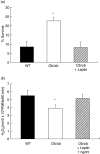Leptin improves pulmonary bacterial clearance and survival in ob/ob mice during pneumococcal pneumonia
- PMID: 17822444
- PMCID: PMC2219341
- DOI: 10.1111/j.1365-2249.2007.03491.x
Leptin improves pulmonary bacterial clearance and survival in ob/ob mice during pneumococcal pneumonia
Abstract
The adipocyte-derived hormone leptin is an important regulator of appetite and energy expenditure and is now appreciated for its ability to control innate and adaptive immune responses. We have reported previously that the leptin-deficient ob/ob mouse exhibited increased susceptibility to the Gram-negative bacterium Klebsiella pneumoniae. In this report we assessed the impact of chronic leptin deficiency, using ob/ob mice, on pneumococcal pneumonia and examined whether restoring circulating leptin to physiological levels in vivo could improve host defences against this pathogen. We observed that ob/ob mice, compared with wild-type (WT) animals, exhibited enhanced lethality and reduced pulmonary bacterial clearance following Streptococcus pneumoniae challenge. These impairments in host defence in ob/ob mice were associated with elevated levels of lung tumour necrosis factor (TNF)-alpha, macrophage inflammatory peptide (MIP)-2 [correction added after online publication 28 September 2007: definition of MIP corrected], prostaglandin E(2) (PGE(2)), lung neutrophil polymorphonuclear leukocyte (PMN) counts, defective alveolar macrophage (AM) phagocytosis and PMN killing of S. pneumoniae in vitro. Exogenous leptin administration to ob/ob mice in vivo improved survival and greatly improved pulmonary bacterial clearance, reduced bacteraemia, reconstituted AM phagocytosis and PMN H(2)O(2) production and killing of S. pneumoniae in vitro. Our results demonstrate, for the first time, that leptin improves pulmonary bacterial clearance and survival in ob/ob mice during pneumococcal pneumonia. Further investigations are warranted to determine whether there is a potential therapeutic role for this adipokine in immunocompromised patients.
Figures




References
-
- Zhang Y, Proenca R, Maffei M, Barone M, Leopold L, Friedman J. Positional cloning of the mouse obese gene and its human homologue. Nature. 1994;372:425–32. - PubMed
-
- Frederich RC, Hamann A, Anderson S, Lollmann B, Lowell BB, Flier JS. Leptin levels reflect body lipid content in mice: evidence for diet-induced resistance to leptin action. Nat Med. 1995;12:1311–4. - PubMed
-
- Boden G, Chen X, Mozzoli M, Ryan I. Effect of fasting on serum leptin in normal human subjects. J Clin Endocrinol Metab. 1996;81:3419–23. - PubMed
-
- Hoggarda N, Mercerb JG, Raynera DV, Moarb K, Trayhurna P, Williams LM. Localization of leptin receptor mRNA splice variants in murine peripheral tissues by RT–PCR and in situ hybridization. Biochem Biophys Res Commun. 1997;232:383–7. - PubMed
Publication types
MeSH terms
Substances
Grants and funding
LinkOut - more resources
Full Text Sources
Molecular Biology Databases
Miscellaneous

